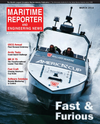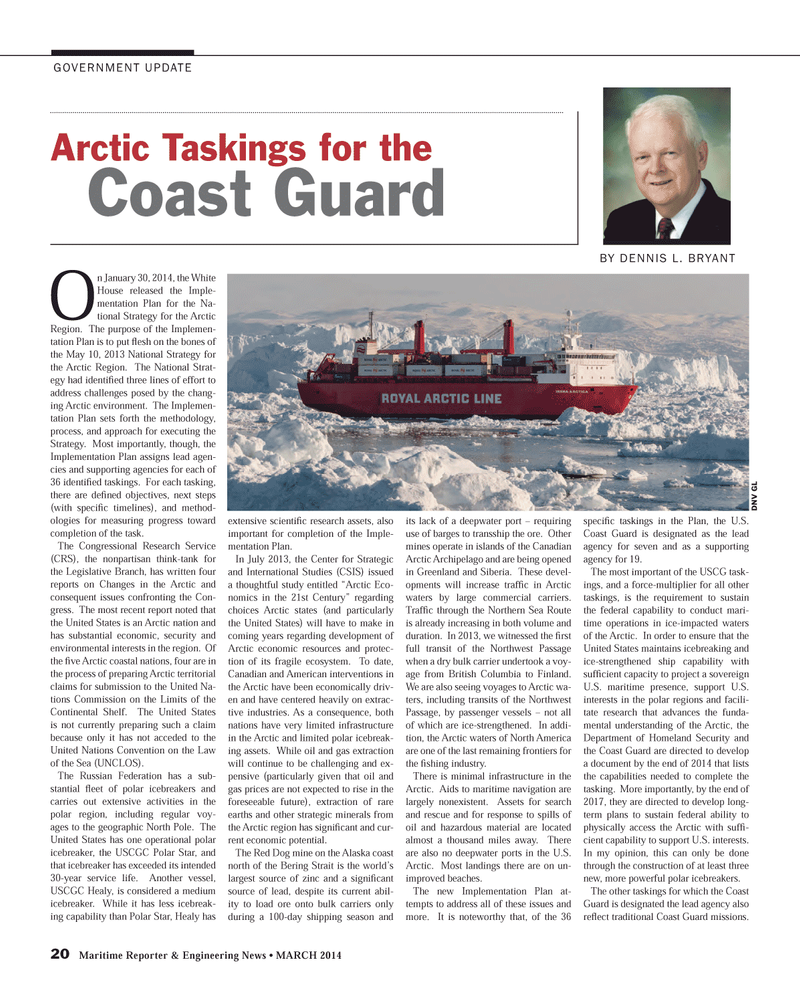
Page 20: of Maritime Reporter Magazine (March 2014)
U.S. Coast Guard Annual
Read this page in Pdf, Flash or Html5 edition of March 2014 Maritime Reporter Magazine
20 Maritime Reporter & Engineering News • MARCH 2014
GOVERNMENT UPDATE
O n January 30, 2014, the White
House released the Imple- mentation Plan for the Na- tional Strategy for the Arctic
Region. The purpose of the Implemen- tation Plan is to put fl esh on the bones of the May 10, 2013 National Strategy for the Arctic Region. The National Strat- egy had identifi ed three lines of effort to address challenges posed by the chang- ing Arctic environment. The Implemen- tation Plan sets forth the methodology, process, and approach for executing the
Strategy. Most importantly, though, the
Implementation Plan assigns lead agen- cies and supporting agencies for each of 36 identifi ed taskings. For each tasking, there are defi ned objectives, next steps (with specifi c timelines), and method- ologies for measuring progress toward completion of the task.
The Congressional Research Service (CRS), the nonpartisan think-tank for the Legislative Branch, has written four reports on Changes in the Arctic and consequent issues confronting the Con- gress. The most recent report noted that the United States is an Arctic nation and has substantial economic, security and environmental interests in the region. Of the fi ve Arctic coastal nations, four are in the process of preparing Arctic territorial claims for submission to the United Na- tions Commission on the Limits of the
Continental Shelf. The United States is not currently preparing such a claim because only it has not acceded to the
United Nations Convention on the Law of the Sea (UNCLOS).
The Russian Federation has a sub- stantial fl eet of polar icebreakers and carries out extensive activities in the polar region, including regular voy- ages to the geographic North Pole. The
United States has one operational polar icebreaker, the USCGC Polar Star, and that icebreaker has exceeded its intended 30-year service life. Another vessel,
USCGC Healy, is considered a medium icebreaker. While it has less icebreak- ing capability than Polar Star, Healy has extensive scientifi c research assets, also important for completion of the Imple- mentation Plan.
In July 2013, the Center for Strategic and International Studies (CSIS) issued a thoughtful study entitled “Arctic Eco- nomics in the 21st Century” regarding choices Arctic states (and particularly the United States) will have to make in coming years regarding development of
Arctic economic resources and protec- tion of its fragile ecosystem. To date,
Canadian and American interventions in the Arctic have been economically driv- en and have centered heavily on extrac- tive industries. As a consequence, both nations have very limited infrastructure in the Arctic and limited polar icebreak- ing assets. While oil and gas extraction will continue to be challenging and ex- pensive (particularly given that oil and gas prices are not expected to rise in the foreseeable future), extraction of rare earths and other strategic minerals from the Arctic region has signifi cant and cur- rent economic potential.
The Red Dog mine on the Alaska coast north of the Bering Strait is the world’s largest source of zinc and a signifi cant source of lead, despite its current abil- ity to load ore onto bulk carriers only during a 100-day shipping season and its lack of a deepwater port – requiring use of barges to transship the ore. Other mines operate in islands of the Canadian
Arctic Archipelago and are being opened in Greenland and Siberia. These devel- opments will increase traffi c in Arctic waters by large commercial carriers.
Traffi c through the Northern Sea Route is already increasing in both volume and duration. In 2013, we witnessed the fi rst full transit of the Northwest Passage when a dry bulk carrier undertook a voy- age from British Columbia to Finland.
We are also seeing voyages to Arctic wa- ters, including transits of the Northwest
Passage, by passenger vessels – not all of which are ice-strengthened. In addi- tion, the Arctic waters of North America are one of the last remaining frontiers for the fi shing industry.
There is minimal infrastructure in the
Arctic. Aids to maritime navigation are largely nonexistent. Assets for search and rescue and for response to spills of oil and hazardous material are located almost a thousand miles away. There are also no deepwater ports in the U.S.
Arctic. Most landings there are on un- improved beaches.
The new Implementation Plan at- tempts to address all of these issues and more. It is noteworthy that, of the 36 specifi c taskings in the Plan, the U.S.
Coast Guard is designated as the lead agency for seven and as a supporting agency for 19.
The most important of the USCG task- ings, and a force-multiplier for all other taskings, is the requirement to sustain the federal capability to conduct mari- time operations in ice-impacted waters of the Arctic. In order to ensure that the
United States maintains icebreaking and ice-strengthened ship capability with suffi cient capacity to project a sovereign
U.S. maritime presence, support U.S. interests in the polar regions and facili- tate research that advances the funda- mental understanding of the Arctic, the
Department of Homeland Security and the Coast Guard are directed to develop a document by the end of 2014 that lists the capabilities needed to complete the tasking. More importantly, by the end of 2017, they are directed to develop long- term plans to sustain federal ability to physically access the Arctic with suffi - cient capability to support U.S. interests.
In my opinion, this can only be done through the construction of at least three new, more powerful polar icebreakers.
The other taskings for which the Coast
Guard is designated the lead agency also refl ect traditional Coast Guard missions.
Arctic Taskings for the Coast Guard
BY DENNIS L. BRYANT
DNV GL
MR #3 (18-25).indd 20 3/5/2014 9:42:55 AM

 19
19

 21
21
